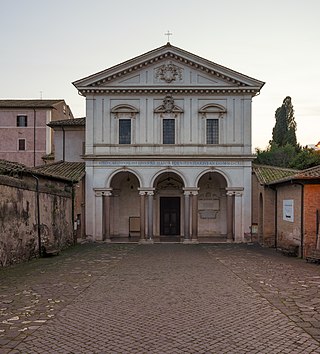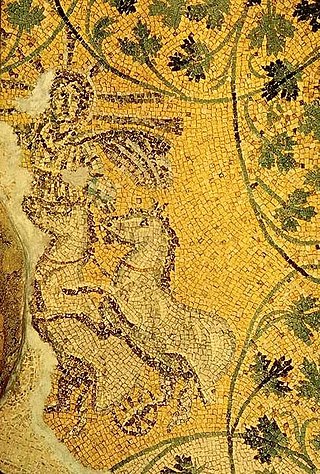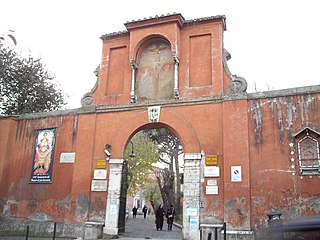
Agnes of Rome is a virgin martyr, venerated as a saint in the Catholic Church, Oriental Orthodox Church and the Eastern Orthodox Church, as well as the Anglican Communion and Lutheran Churches. She is one of several virgin martyrs commemorated by name in the Canon of the Mass.

The Catacombs of Rome are ancient catacombs, underground burial places in and around Rome, of which there are at least forty, some rediscovered only in recent decades. Though most famous for Christian burials, either in separate catacombs or mixed together, Jews and also adherents of a variety of pagan Roman religions were buried in catacombs, beginning in the 2nd century AD, occasioned by the ancient Roman ban on burials within a city, and also as a response to overcrowding and shortage of land. The most extensive and perhaps the best known is the Christian Catacomb of Callixtus located near the Park of the Caffarella, but there are other sites, both Christian and not, scattered around the city, some of which are now engulfed by modern urban sprawl.

The Basilica Papale di San Lorenzo fuori le mura is a Roman Catholic papal minor basilica and parish church, located in Rome, Italy. The Basilica is one of the Seven Pilgrim Churches of Rome and one of the five "papal basilicas", each of which was assigned to the care of a Latin Church patriarchate. The basilica was assigned to the Patriarchate of Jerusalem. The basilica is the shrine of the tomb of its namesake, Lawrence, one of the first seven deacons of Rome who was martyred in 258. Many other saints and Pope Pius IX are also buried at the Basilica, which is the centre of a large and ancient burial complex.

The church of Saint Agnes Outside the Walls is a titulus church, minor basilica in Rome, on a site sloping down from the Via Nomentana, which runs north-east out of the city, still under its ancient name. What are said to be the remains of Saint Agnes are below the high altar. The church is built over the Catacombs of Saint Agnes, where the saint was originally buried, and which may still be visited from the church. A large basilica with the same name was built nearby in the 4th century and its ruins can be seen near Santa Costanza, in the same site. The existing church was built by Pope Honorius I in the 7th century, and largely retains its original structure, despite many changes to the decoration. In particular the mosaic in the apse of Agnes, Honorius, and another Pope is largely in its original condition. The current Cardinal Priest of the Titulus S. Agnetis Extra moenia is Camillo Ruini.

San Sebastiano fuori le mura, or San Sebastiano ad Catacumbas, is a minor basilica in Rome, Central Italy. Up to the Great Jubilee of 2000, San Sebastiano was one of the Seven Pilgrim Churches of Rome, and many pilgrims still favour the traditional list.

Santa Costanza is a 4th-century church in Rome, Italy, on the Via Nomentana, which runs north-east out of the city. It is a round building with well preserved original layout and mosaics. It has been built adjacent to a horseshoe-shaped church, now in ruins, which has been identified as the initial 4th-century cemeterial basilica of Saint Agnes. Santa Costanza and the old Saint Agnes were both constructed over the earlier catacombs in which Saint Agnes is believed to be buried.

Nereus and Achilleus are two Roman martyr saints. In the present General Roman Calendar, revised in 1969, Nereus and Achilleus (together) are celebrated on 12 May.

The basilica of San Pancrazio is a Roman Catholic ancient basilica and titular church founded by Pope Symmachus in the 6th century in Rome, Italy. It stands in via S. Pancrazio, westward beyond the Porta San Pancrazio that opens in a stretch of the Aurelian Wall on the Janiculum. It covers the Catacomb of San Pancrazio.

Settecamini is the 6th zona of Rome, identified by the initials Z. VI.. Settecamini is also the name of the urban zone 5L, within the Municipio V of Rome.

The Porta Nomentana was one of the gates in the Aurelian Walls of Rome, Italy. It is located along viale del Policlinico, around 70 m east of Porta Pia. It is now blocked and merely a boundary wall for the British Embassy.

The Vatican Necropolis lies under the Vatican City, at depths varying between 5–12 metres below Saint Peter's Basilica. The Vatican sponsored archaeological excavations under Saint Peter's in the years 1940–1949 which revealed parts of a necropolis dating to Imperial times. The work was undertaken at the request of Pope Pius XI who wished to be buried as close as possible to Peter the Apostle. It is also home to the Tomb of the Julii, which has been dated to the third or fourth century. The necropolis was not originally one of the Catacombs of Rome, but an open-air cemetery with tombs and mausolea.

The Mausoleum of Helena is an ancient building in Rome, Italy, located on the Via Casilina, corresponding to the 3rd mile of the ancient Via Labicana. It was built by the Roman emperor Constantine I between 326 and 330, originally as a tomb for himself, but later assigned to his mother, Helena, who died in 330.

The Vigna Randanini are Jewish Catacombs between the second and third miles of the Appian Way close to the Christian catacombs of Saint Sebastian, with which they were originally confused. The catacombs date between the 2nd and 5th-centuries CE, and take their name from the owners of the land when they were first formally discovered and from the fact that the land was used as a vineyard (vigna). While Vigna Randanini are just one of the two Jewish catacombs in Rome open to the public, they can only be visited by appointment. They are situated below a restaurant and a private villa and entrance is from the Via Appia Pignatelli side. These catacombs were discovered by accident in 1859, although there is evidence that they had been pillaged before then. They cover an area of 18,000 square metres and the tunnels are around 700 metres long, of which around 400 can be seen.

The Catacomb of Generosa is a catacomb of Rome (Italy), located in Via delle Catacombe di Generosa, close to a big bight of river Tiber on the right bank, in the Portuense quarter.
The Catacombs of San Valentino is one of the catacombs of Rome (Italy), placed at the 2nd mile of the via Flaminia, now in Viale Maresciallo Pilsudski, in the modern Pinciano neighborhood.

The Catacomb of San Pancrazio is a catacomb of Rome (Italy), located in the Via Aurelia, within the modern Quartiere Gianicolense.

The Catacombs of Saint Gaudiosus are underground paleo-Christian burial sites, located in the northern area of the city of Naples.

The Catacombs of San Sebastiano are a hypogeum cemetery in Rome, Italy, rising along Via Appia Antica, in the Ardeatino Quarter. It is one of the very few Christian burial places that has always been accessible. The first of the former four floors is now almost completely destroyed.

The Catacomb of Saint Thecla is a Christian catacomb in the city of Rome, near the Via Ostiense and the Basilica of Saint Paul Outside the Walls, in the southern quarter of the ancient city. The catacomb was constructed in the fourth century of the Common Era, linked with a basilica to the saint that is alluded to in literature. Because of the enigmatic endings of the legends of Saint Thecla of Iconium, it is still unknown whether the tomb belongs to the saint or if it belongs to a different noblewoman. Regardless, the tomb is an example of early Christian funerary practice and artwork. The most recent discovery in the catacomb was the depiction of several apostles, hypothesized to be their earliest portrayals. Of particular interest to many is the portrait of the Apostle Paul.

Trieste is the 17th quarter of Rome (Italy), identified by the initials Q. XVII.



















